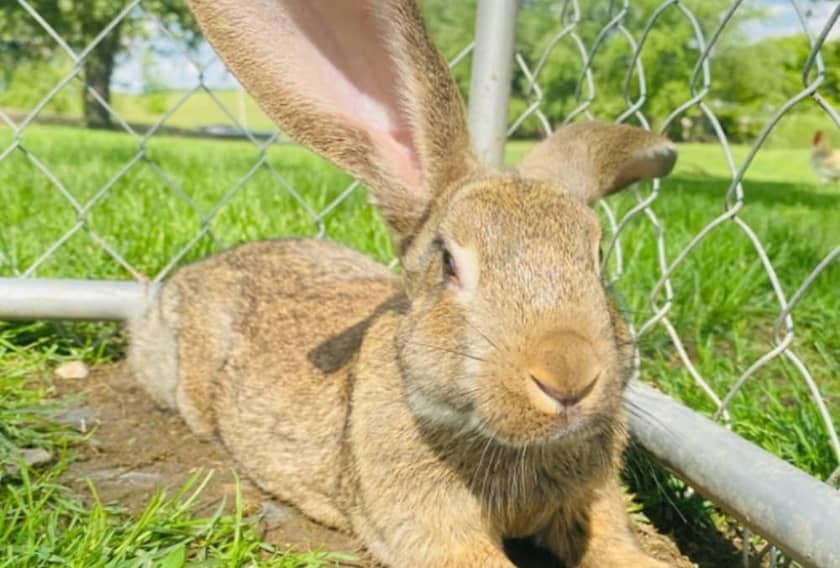The crested gecko is known for their unique and captivating appearance. They have a distinctive “eyelash” crest running from above their eyes down to their necks, which gives them an expressive look and adds to their charm. The crested geckos are native to New Caledonia, a group of islands located in the South Pacific, east of Australia. They are primarily found in the dense, humid forests of the islands, where they live among trees and foliage.

The climate in New Caledonia is tropical, which provides a warm, humid environment that crested geckos thrive in. These geckos come in various colors and patterns, ranging from shades of brown, red, orange, yellow, and cream, with patterns like spots, stripes, or marbling. Their skin is soft and somewhat velvety to the touch, and they have large, round eyes with slit-shaped pupils, which are well-suited for their nocturnal lifestyle.
Crested geckos have slender bodies with long limbs and toes equipped with sticky pads, allowing them to grip and climb surfaces easily. Moreover, they have a prehensile tail, which can help in balance and movement. This unique combination of features makes the crested gecko a visually striking and memorable reptile pet. Crested geckos The scientific name of the crested gecko is Rhacodactylus ciliatus.
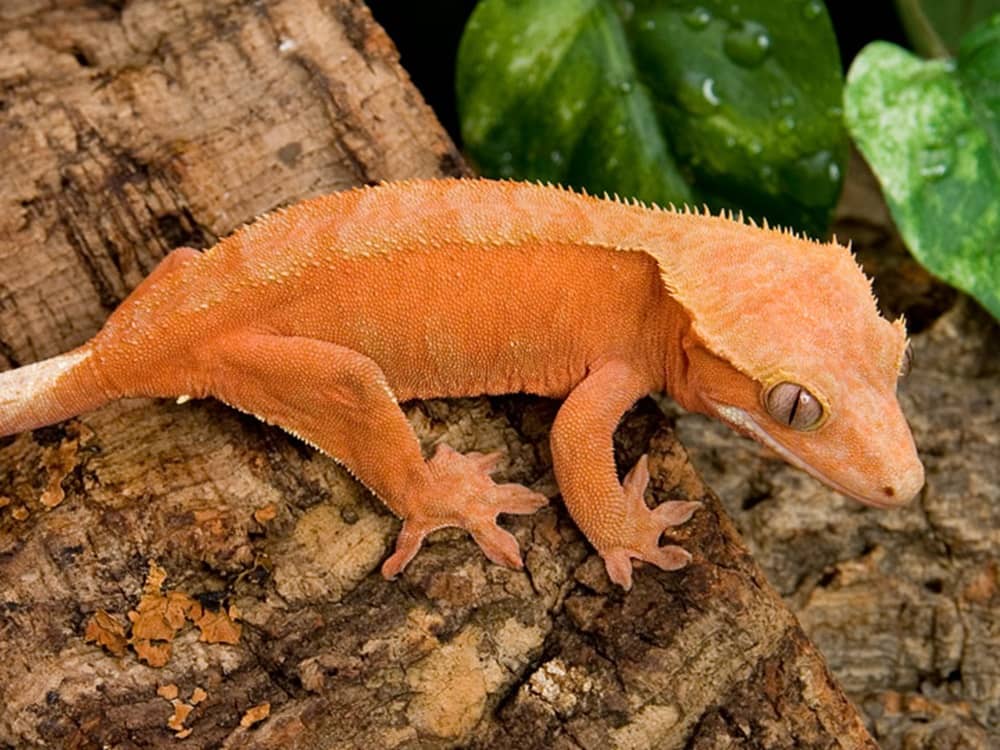
Crested geckos primarily feed on a diet of fruit and insects, with ripe fruits like papaya and mashed banana. They can also thrive on commercially prepared powdered diets that are specifically formulated for them, providing the necessary nutrients for their health.
Table of Contents
ToggleCrested Gecko Size
The size of the crested gecko ranges from 7 to 9 inches long, including its prehensile tail. They typically weigh between 30 and 70 grams (1 to 2.5 ounces), depending on age, size, and overall health.
Crested Gecko Lifespan
Crested geckos can live up to 10 to 20 years in captivity with proper care, attention, and diet.
Male vs. Female Crested Gecko
| Feature | Male Crested Gecko | Female Crested Gecko |
|---|---|---|
| Size | Generally larger, averaging 8 to 10 inches (20 to 25 cm) | Slightly smaller, averaging 7 to 9 inches (18 to 23 cm) |
| Weight | Heavier, typically 50 to 70 grams (1.7 to 2.5 ounces) | Lighter, typically 30 to 60 grams (1 to 2.1 ounces) |
| Body Structure | More robust and muscular | Slimmer with a more slender body |
| Crest Size | Often has a more pronounced crest | The crest may be less prominent |
| Hemipenal Bulges | Visible hemipenal bulges at the base of the tail | No bulges; body shape is more uniform |
| Behavior | More territorial and can exhibit dominant behaviors | Generally more docile and less territorial |
| Breeding Capability | Breeds with females during mating season | Can lay eggs; typically lays 1-2 eggs per clutch |
| Coloration | It can have a wider range of colors and patterns | Typically, it has more muted colors but can vary |
Crested Gecko Behavior and Temperament
Crested geckos have a docile and curious temperament, which makes them popular pets. These geckos are typically calm and can adapt well to handling, although they may exhibit occasional bursts of activity or nervousness, especially when young or newly acquired. So, they do not like to be held much, so avoid as much as you can hold.
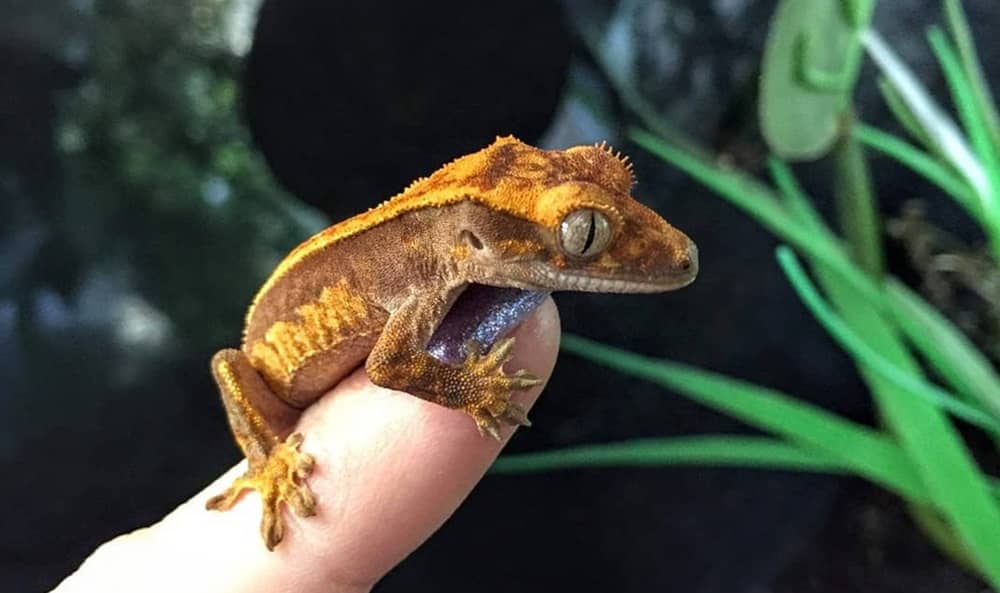
Crested geckos may drop their tails if they hold roughly or tightly; unlike some other gecko species, they won’t regenerate, or they can even bite; although their bite is not as strong or dangerous, they can still bite if they feel threatened. Their behavior in captivity is generally mild-mannered, and they love to explore, climb, and hide among branches and plants. Crested geckos are nocturnal, becoming most active during the evening and night hours. They have prehensile tails, which are used to hold objects or jump from branches to branches.
How to Care for a Crested Gecko?
To maintain your pet’s crested gecko’s health, you need to be careful with their requirements, whether it’s diet, grooming, housing, or exercise.
Crested Gecko Food
The best way to fulfill crested geckos’ nutritious and balanced diet is to provide them with a commercial diet that contains all the essential nutrients, vitamins, and minerals. These prepared diets are often fruit-flavored to mimic their natural preference for fruits and nectar and are easy to prepare. Also, you can supplement their diet with some crickets and other prey insects like roaches, waxworms, and silkworms. Crested geckos should not eat mealworms because they have a hard, indigestible exoskeleton.
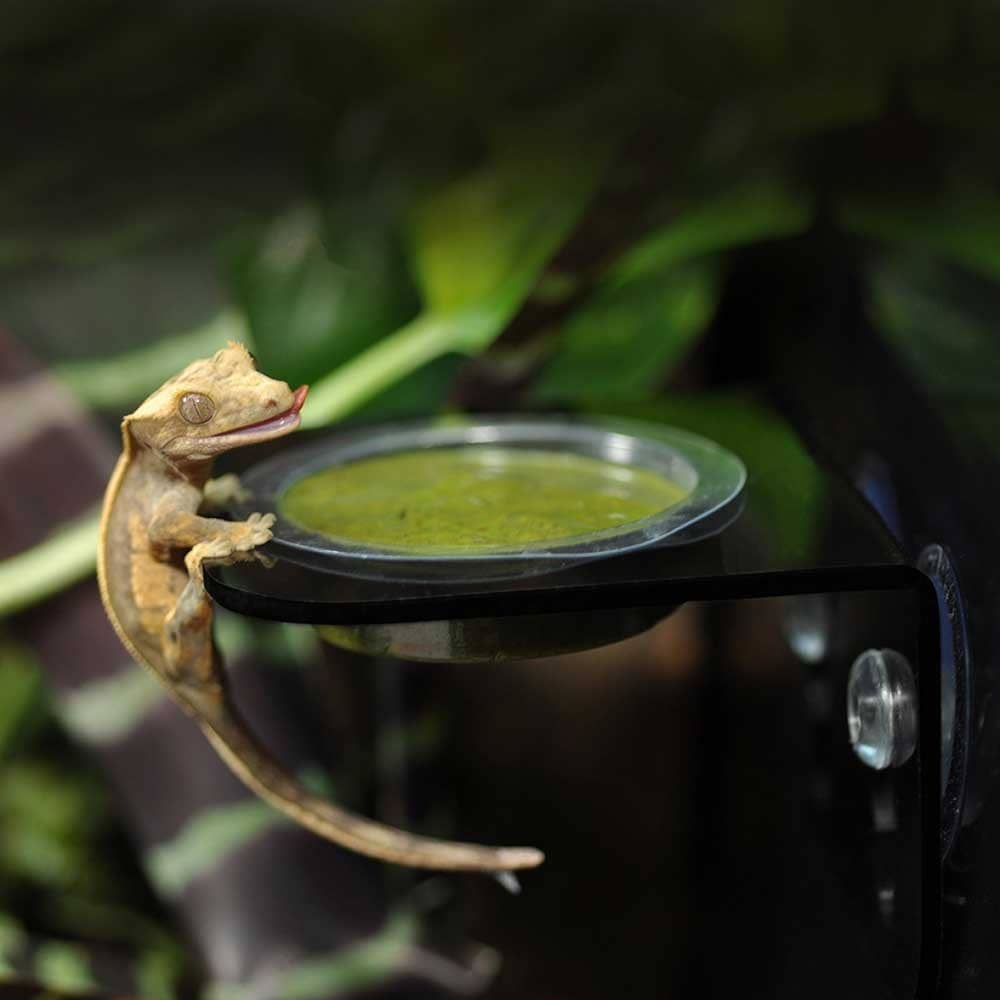
You can also add some treats occasionally, like mashed fruits, especially mango, papaya, and banana, but these should only supplement a balanced diet. Fresh water should always be available in a shallow dish or misted on leaves within their enclosure, as crested geckos often drink from droplets. A balanced diet of both commercial food and occasional insects ensures they receive essential nutrients and helps them maintain a healthy weight.
Crested Gecko Enclosure
If you want your crested gecko to stay healthy and strong, free from health issues, you have to keep the necessities for caring for crested gecko in mind, like their enclosure.
Crested Gecko Tank Size
An adult crested gecko tank should be a vertically oriented enclosure. The crested gecko tank size should be a 20-gallon tall tank (roughly 18x18x24 inches). This size allows enough vertical space to accommodate their instinct to climb and explore. The enclosure should have room for branches, vines, plants, and hiding spots that mimic the gecko’s natural environment.
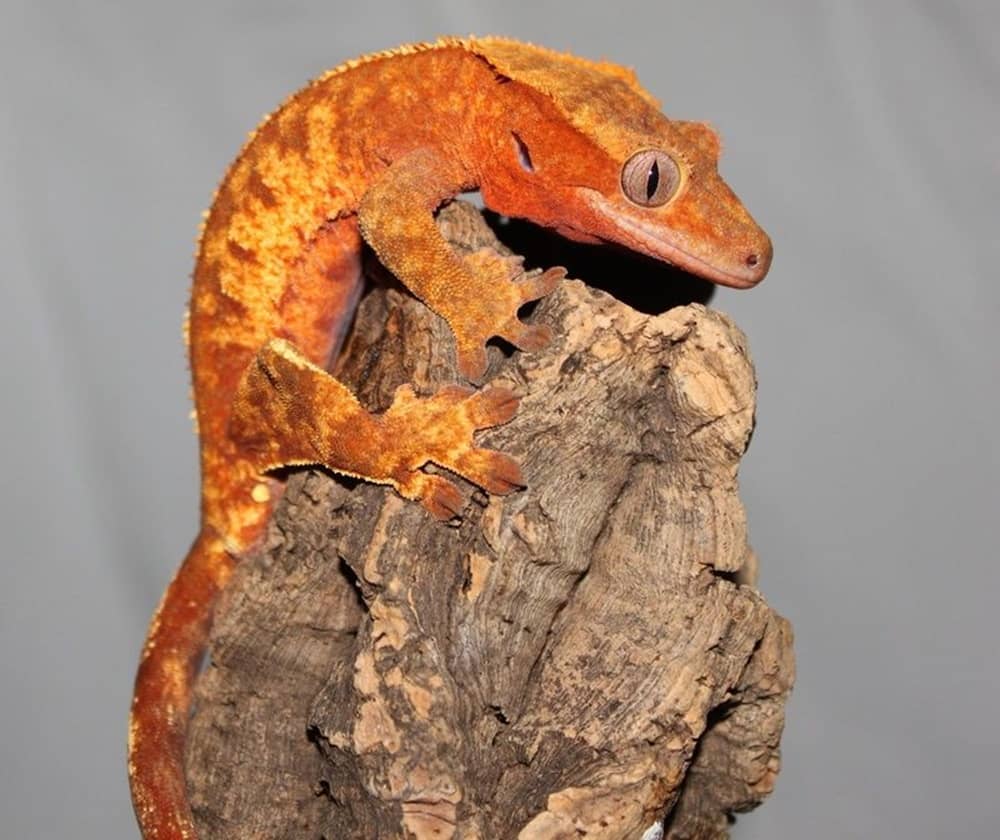
Juveniles or hatchlings can be housed temporarily in smaller enclosures, such as a 10-gallon tank, as this smaller space can make it easier for them to locate food. However, you can upgrade to a larger tank as they mature to keep them active. In cases where multiple crested geckos are housed together, a 30-gallon or larger tank is ideal to prevent territorial issues and ensure each gecko has sufficient space to establish its area within the enclosure.
Temperature for Crested Gecko Tank
Temperatures for Crested gecko tanks where they can thrive range from 72–78°F during the day. Nighttime temperatures for crested gecko tanks can drop slightly to around 65–70°F, as they are adapted to cooler nights. You should avoid exposing them to temperatures above 82°F, as this can cause stress and overheating. If room temperatures fall below 65°F at night, a low-wattage ceramic heater or heat mat can be used to maintain warmth.
However, avoid direct heat sources like heat lamps, as crested geckos are sensitive to overheating. You can use a digital thermometer inside the tank to monitor temperatures accurately.
Crested Gecko Humidity Level
The crested gecko’s humidity level should be between 60–80% to stay healthy and hydrated. Humidity should be kept higher at night, around 80%, as this is when they are most active, and it can drop to about 50–60% during the day. You need to do regular misting in the morning and evening to maintain humidity levels and provide droplets from which they can drink. It’s essential to allow some drying out between mistings to prevent mold growth and respiratory issues. You can use a digital hygrometer to monitor humidity accurately.
Crested Gecko Light Setup
Crested gecko light setups do not require intense lighting or UVB exposure like leopard geckos, but a gentle light cycle helps regulate their day-night rhythm. You can use a low-wattage LED or daylight bulb to mimic natural daylight, keeping a cycle of 12 hours of light and 12 hours of darkness.
A low-level UVB light (2–5%) can be beneficial in small doses to support calcium absorption and overall health, though it should not exceed 10–12 hours daily. You can place any lighting outside the tank or with a protective cover to prevent direct exposure, as crested geckos are sensitive to bright light and heat.
Crested Gecko Substrate
For a crested gecko enclosure, choosing the right crested gecko substrate is important to create a safe environment. You can use substrates including eco-friendly options like coconut fiber, soil mixes designed for reptiles, or a blend of organic soil and sphagnum moss. These substrates help retain moisture, support the enclosure’s humidity, and allow for digging or burrowing, which some crested geckos enjoy. Paper towels or reptile carpets are also safe options, especially for juvenile geckos, as they’re easy to clean and reduce the risk of impaction. You should avoid loose substrates like sand, wood chips, or gravel, as these can pose health risks if ingested. Proper crested gecko substrate choice ensures a clean, comfortable environment for your crested gecko.
How to Handle a Crested Gecko?
You need patience and gentleness to handle a crested gecko to ensure both the gecko’s comfort and your safety. You should handle them during the evening or night when they are naturally more active. Before handling, wash your hands to remove any contaminants and avoid strong scents that may stress the gecko. You can approach slowly, allowing the gecko to see and recognize your hand before gently scooping it up from underneath, supporting its body while avoiding direct contact with the tail, as it can shed in response to stress.
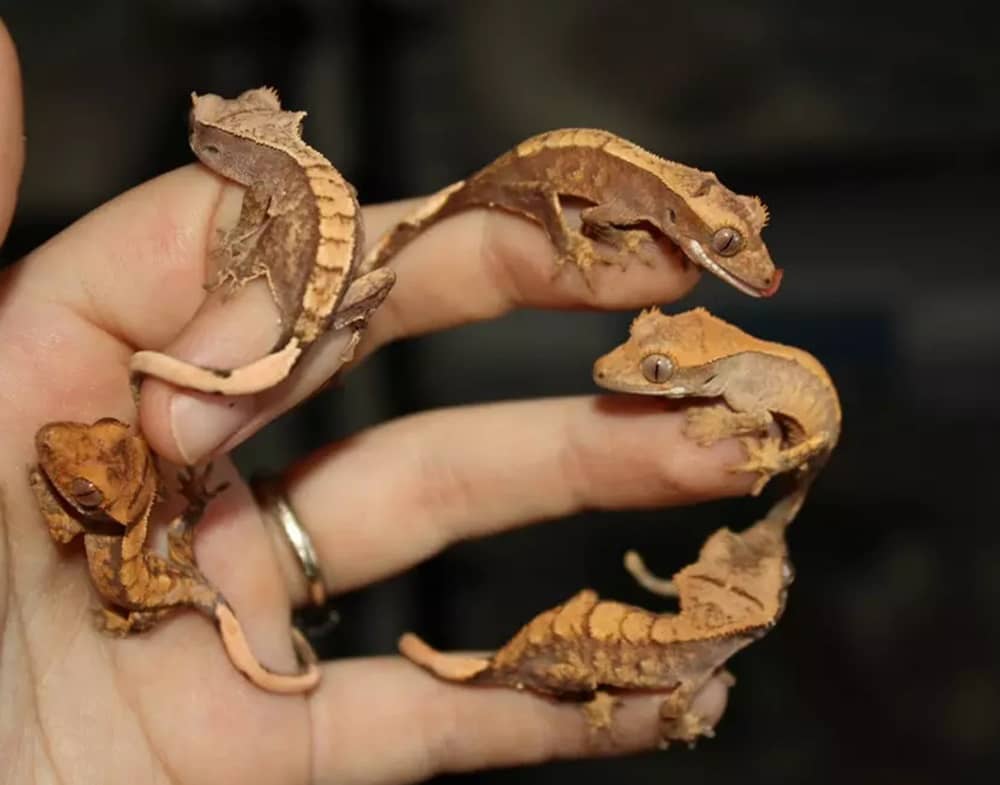
Keep your hands low to the ground or have a soft surface beneath them to prevent injury if they jump or fall, as crested geckos are known for their agility. As they do not like much handling, limit handling sessions to around 5-10 minutes. You should always watch for signs of stress, such as tail twitching or attempts to escape, and return the gecko to its enclosure gently to help it acclimate back to its environment.
Exercise For Crested Geckos
Exercise for crested geckos is essential to maintaining their physical fitness and preventing obesity. You should provide a stimulating environment with various climbing structures, such as branches, vines, and rocks, that encourage them to explore and engage in their natural arboreal behaviors. Adding hiding spots and foliage creates a secure habitat where geckos can feel safe, and improves their overall health.
You can also give lightweight toys or interactive objects that can promote activity. It is advisable to integrate these activities into their daily routine. So you can ensure your crested gecko remains active and healthy.
Health Issues of a Crested Gecko
Metabolic bone disease (MBD) is a condition that occurs from a lack of calcium and UVB exposure. It leads to weak bones and deformities. Lethargy, trembling, and difficulty moving are the symptoms. You should provide a balanced diet, proper calcium supplementation, and UVB lighting can help prevent MBD. Respiratory infections can occur due to poor humidity levels, temperature fluctuations, and unsanitary conditions.
Wheezing, coughing, nasal discharge, and lethargy are the signs of respiratory infections. You should provide proper humidity and temperature for prevention. Parasites can be internal and external parasites, such as mites or intestinal worms, that can affect crested geckos. Symptoms may include weight loss, lethargy, abnormal feces, or visible signs of irritation on the skin. You should take your gecko to the vet for regular checkups.
Crested geckos can become dehydrated, especially if they do not have access to clean water or if humidity levels are too low. Sunken eyes, lethargy, and dry skin can be the signs of dehydration. You need to do regular misting, and providing a shallow dish of fresh water can help prevent dehydration. Overfeeding or an improper diet can lead to obesity, which can cause a range of health issues in your gecko.
Grooming of Crested Gecko
Grooming of crested geckos is minimal but essential for maintaining their health and comfort. Crested geckos will shed their skin regularly, typically every few weeks. If you notice any retained skin, especially around the toes or eyes, gently misting the gecko or providing a damp hide can help. You should regularly clean the enclosure, remove uneaten food, shed skin, and waste daily, and perform a thorough cleaning with a reptile-safe disinfectant weekly.
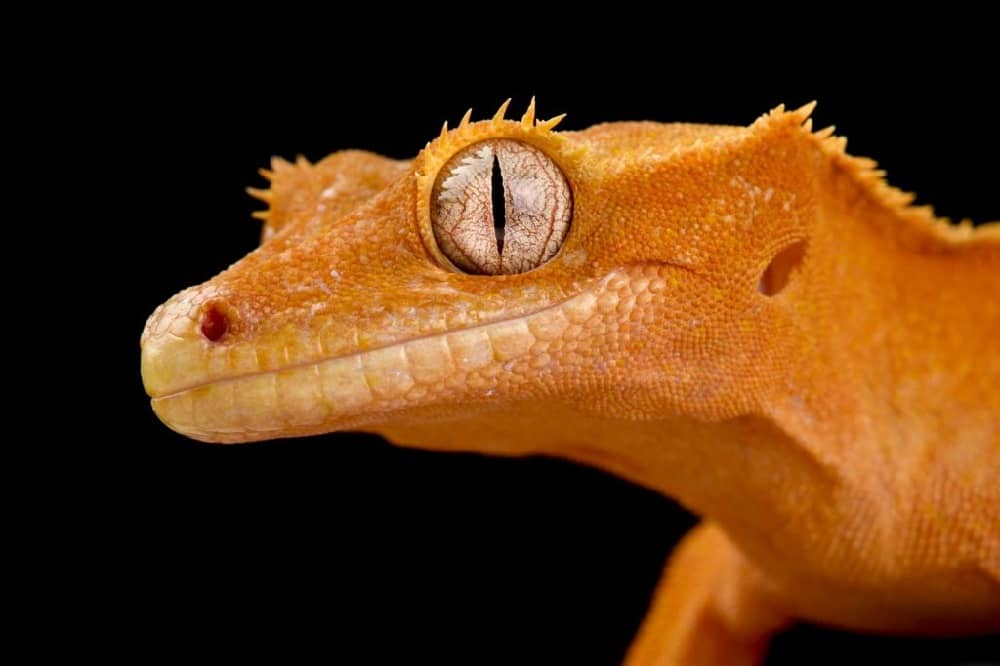
Additionally, while crested geckos naturally wear down their nails through climbing, you may need to trim them if they become too long, using reptile-safe clippers or a file. Regularly check your gecko’s skin for any signs of irritation, infections, or parasites, as a healthy gecko should have smooth, vibrant skin. Although they do not require regular baths, occasional gentle rinsing with lukewarm water can help keep them clean.
Where to Buy
When purchasing a crested gecko, you should learn about the species’ needs, such as its diet, environment, and health problems. You can purchase them from a reputable pet shop. Additionally, please make sure the store is hygienic and sanitary for their reptiles. Another option is to purchase from a respectable Gecko breeder. Breeders can offer comprehensive details regarding the gecko’s ancestry, medical background, and maintenance requirements. Additionally, you can contact online breeders to choose the ideal crested gecko for you.
It would help if you looked for indications of good health before buying a crested gecko. Check for appropriate body weight, healthy skin free of discolorations or blemishes, and clear eyes. The average cost of purchasing a crested gecko is around $50 to $100, depending on age, size, and where you buy it. However, more rare morphs or those with unique colorations may cost upwards of $800 or more.
Crested Gecko For Sale
Reproduction and Breeding
Crested gecko breeding typically occurs during the warmer months, with females requiring specific conditions to stimulate ovulation. A suitable breeding environment includes a temperature range of 72-78°F (22-26°C) and humidity levels around 50-70%. Males may show courtship behaviors, such as head bobbing and vocalizations, to attract females. After successful mating, female crested geckos will lay clutches of one to two eggs, which they usually deposit in a hidden, moist location within the enclosure.
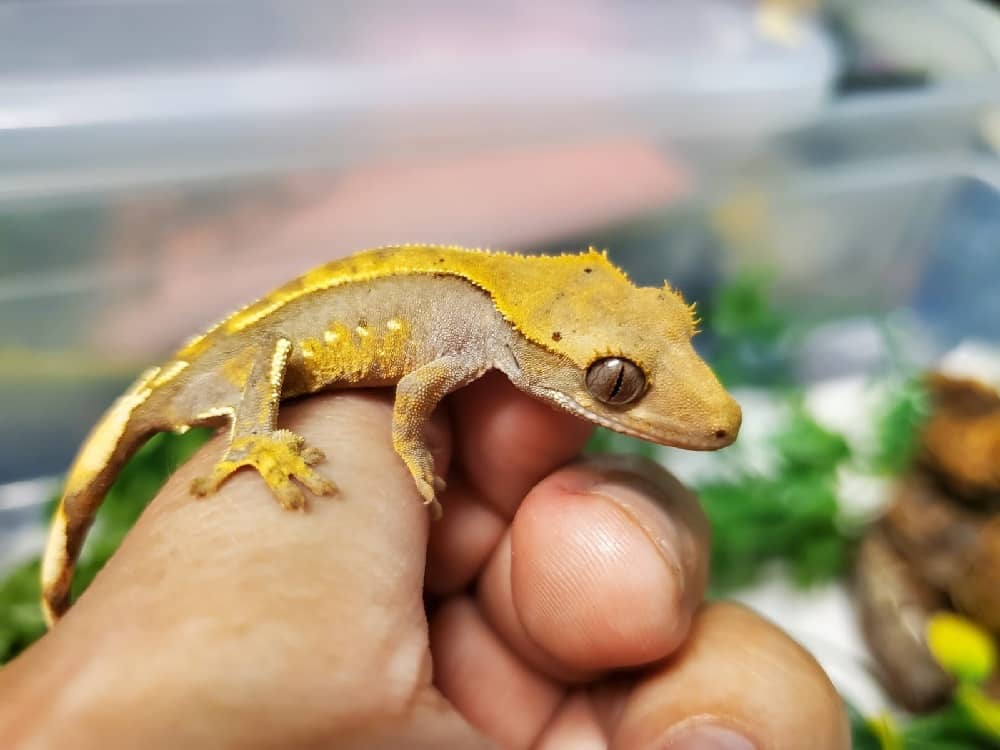
The eggs have an incubation period of about 60-90 days, depending on temperature and humidity, during which it’s crucial to maintain stable conditions to ensure proper development. Hatchlings typically emerge fully formed and require immediate access to food and water. You need to provide a separate, secure habitat for the hatchlings with appropriate humidity and temperature levels to ensure their healthy growth and development.
Related Species
- Common House Gecko (Hemidactylus frenatus)
- Leopard Gecko (Eublepharis macularius)
- Tokay Gecko (Gekko gecko)
- White-lined Gecko (Gekko vittatus)
Interesting Facts About a Crested Gecko
- Crested geckos come in a variety of colors and patterns, including stripes, spots, and various shades of orange, yellow, and brown, making them popular among reptile enthusiasts.
- Crested geckos can shed their tails as a defense mechanism; unlike other geckos, they cannot regenerate their tails.
- Crested geckos are primarily frugivorous, meaning they thrive on a diet rich in fruits. Commercially available crested gecko diet powders provide essential nutrients.
- Crested geckos require humidity levels between 50 and 70% for optimal health, and regular misting helps maintain these levels.
- Crested geckos are nocturnal creatures, being most active at night.
- Male crested geckos can be territorial, so it’s recommended to house them separately to prevent fighting and stress.
- As arboreal lizards, crested geckos need vertical space and climbing structures in their enclosure, such as branches and vines.
- Crested geckos often hydrate through droplets on leaves.
- Crested gecko breeding typically occurs in warmer months, with females laying one to two eggs per clutch every few weeks.
- Crested geckos do not bask like some other reptiles; they rely on their environment to maintain optimal temperatures.
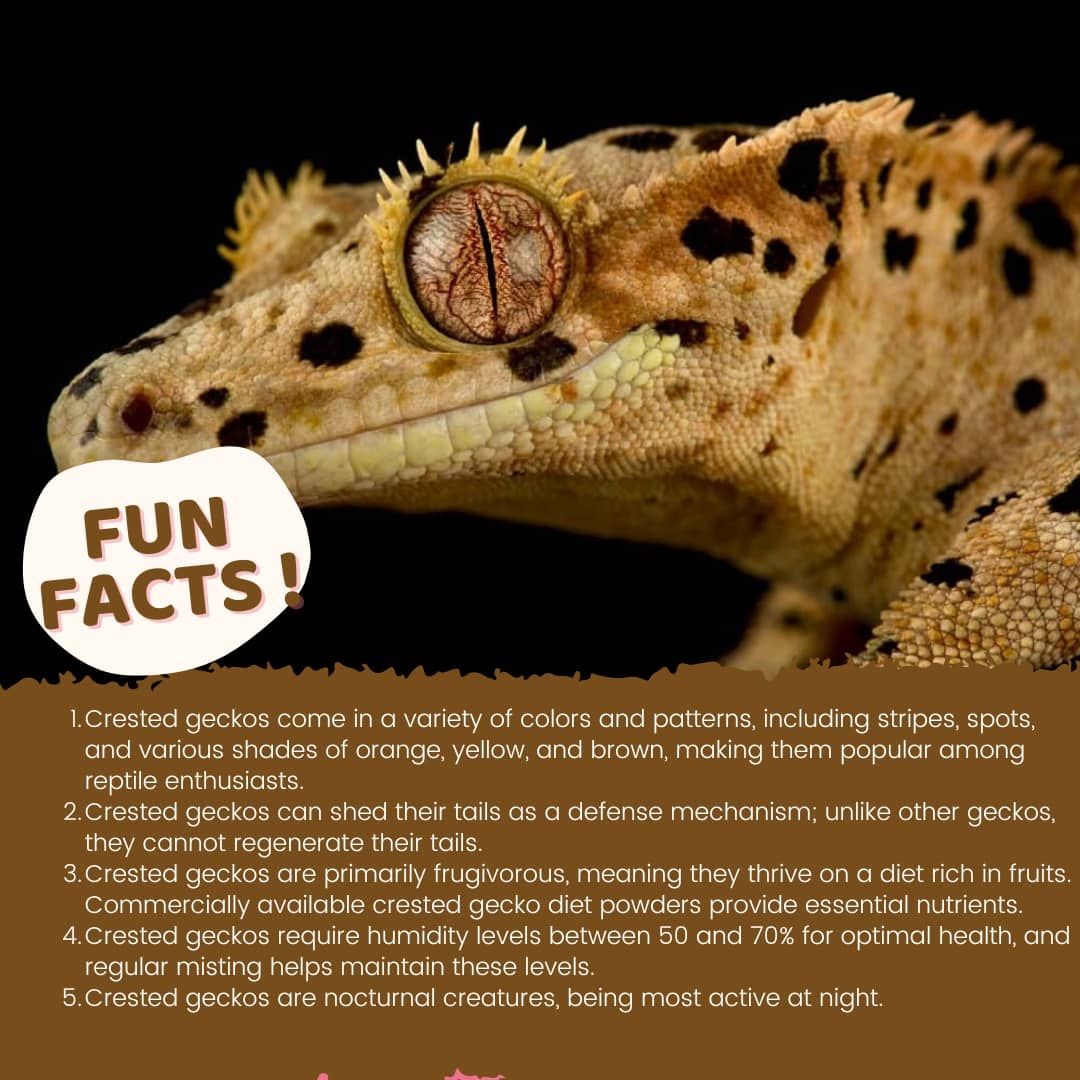
Frequently Asked Questions
Question 1: How often should I feed my crested gecko?
Answer: Adult crested geckos should be fed every other day, while hatchlings may require daily feedings.
Question 2: What temperature should I maintain in the tank?
Answer: The ideal temperature range is between 72-78°F (22-26°C) during the day, with slightly cooler temperatures at night.
Question 3: Do crested geckos need a heat source?
Answer: They do not require direct heat sources but should be kept within the recommended temperature range, which can be achieved at room temperature.
Question 4: How much does crested gecko cost?
Answer: The crested gecko morphs are available at different prices, starting with $100 and more.
Question 5: Can I house multiple crested geckos together?
Answer: Males should not be housed together due to territorial behavior. Females can be kept together if there is enough space and hiding spots.
Question 6: How do I handle my crested gecko?
Answer: Start by gently scooping them up from underneath and allowing them to climb onto your hand. Regular handling helps them become accustomed to human interaction.
Question 7: What do I do if my crested gecko is not eating?
Answer: Monitor their environment for stressors such as temperature changes or inadequate humidity, and consult a veterinarian if the lack of appetite persists.
Question 8: Do crested geckos need UVB lighting?
Answer: While not strictly necessary, providing low-level UVB lighting can be beneficial for their health and calcium metabolism.
Question 9: How do I assist with shedding?
Answer: Maintain proper humidity levels and provide rough surfaces for your pet gecko to rub against during shedding to aid the process.
Question 10: Are crested geckos friendly?
Answer: These are very docile and easy to handle.
Conclusion
In the end, Crested gecko care requires attention to their specific needs for housing, diet, temperature, and health. By providing a well-maintained habitat with appropriate heat, lighting, and humidity, you can ensure your geckos thrive. Gentle handling and grooming can help to build a bond and keep your gecko in good condition. They are adorable reptiles, so keep them safe to ensure a happy, healthy living life for many years.

